Immigration: High Skilled vs. Low Skilled Labor? - Iza
Immigration: High Skilled vs. Low Skilled Labor? - Iza
Immigration: High Skilled vs. Low Skilled Labor? - Iza
Create successful ePaper yourself
Turn your PDF publications into a flip-book with our unique Google optimized e-Paper software.
VII. The Distribution of <strong>High</strong>-Skills by Nativity<br />
It should be noted that there can be a downside to the immigration of high-skilled STEM<br />
workers. As discussed above, the immigration of high-skilled workers tends to depress the<br />
earnings of high-skilled workers in the destination. This tends to depress the domestic rate of<br />
return from investment in these activities, thereby discouraging native youths from investing in<br />
these skills. This may have more of an effect on the distribution of natives and immigrants<br />
across high-skilled activities than on the aggregate number of natives investing in high-skilled<br />
occupations.<br />
Some high-skilled occupations require skills that are highly internationally transferable.<br />
Quantitative skill is one example. Other high-level jobs have more local or destination-specific<br />
characteristics, as is the case for jobs that require linguistic skill or special occupational licensing<br />
requirements. Thus, if one could rank high-level occupations by the extent to which they require<br />
internationally transferable skills and the extent to which they require destination-specific skills,<br />
one should expect to observe high-skilled immigrants concentrating in the former (e.g.,<br />
mathematics or computer technology) and high-skilled natives concentrating in the latter (e.g.<br />
law or marketing).<br />
VIII. Capital and Technology<br />
The discussion thus far has assumed that the capital stock is fixed or held constant.<br />
While this is a reasonable assumption for the short-run, in the long-run there is a greater return to<br />
capital from either low-skilled or high-skilled immigration. The increased return to capital raises<br />
the capital stock by attracting foreign capital, decreasing the export of domestic capital, or<br />
increasing savings and hence the overall supply of domestic capital. To the extent that the<br />
13
















